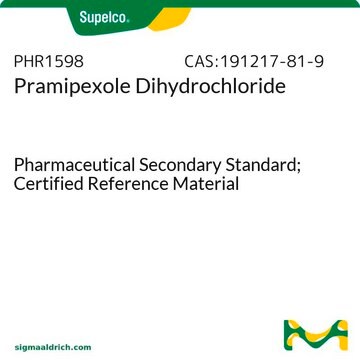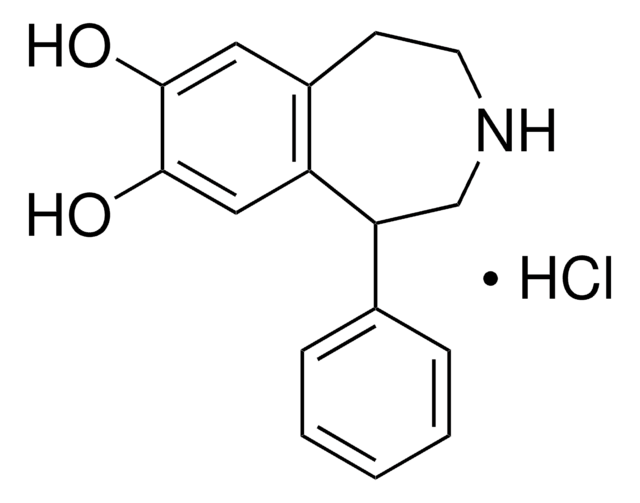A1237
Pramipexole dihydrochloride
>98% (HPLC), powder
Synonyme(s) :
(S)-2-amino-4,5,6,7-tetrahydro-6-(propylamino)benzothiazole dihydrochloride, PPX dihydrochloride
Sélectionner une taille de conditionnement
101,00 $
Sélectionner une taille de conditionnement
About This Item
101,00 $
Produits recommandés
Essai
>98% (HPLC)
Forme
powder
Conditions de stockage
desiccated
Couleur
white to off-white
Solubilité
H2O: >20 mg/mL
Auteur
Boehringer Ingelheim
Température de stockage
2-8°C
Chaîne SMILES
Cl.Cl.CCCN[C@H]1CCc2nc(N)sc2C1
InChI
1S/C10H17N3S.2ClH/c1-2-5-12-7-3-4-8-9(6-7)14-10(11)13-8;;/h7,12H,2-6H2,1H3,(H2,11,13);2*1H/t7-;;/m0../s1
Clé InChI
QMNWXHSYPXQFSK-KLXURFKVSA-N
Informations sur le gène
human ... DRD2(1813) , DRD3(1814) , DRD4(1815)
Description générale
Application
Actions biochimiques/physiologiques
Caractéristiques et avantages
Mention d'avertissement
Warning
Mentions de danger
Conseils de prudence
Classification des risques
Acute Tox. 4 Oral - STOT SE 3
Organes cibles
Central nervous system
Code de la classe de stockage
11 - Combustible Solids
Classe de danger pour l'eau (WGK)
WGK 2
Point d'éclair (°F)
Not applicable
Point d'éclair (°C)
Not applicable
Faites votre choix parmi les versions les plus récentes :
Certificats d'analyse (COA)
Vous ne trouvez pas la bonne version ?
Si vous avez besoin d'une version particulière, vous pouvez rechercher un certificat spécifique par le numéro de lot.
Déjà en possession de ce produit ?
Retrouvez la documentation relative aux produits que vous avez récemment achetés dans la Bibliothèque de documents.
Les clients ont également consulté
Articles
We offer many products related to dopamine receptors for your research needs.
Discover Bioactive Small Molecules for ADME/Tox
Active Filters
Notre équipe de scientifiques dispose d'une expérience dans tous les secteurs de la recherche, notamment en sciences de la vie, science des matériaux, synthèse chimique, chromatographie, analyse et dans de nombreux autres domaines..
Contacter notre Service technique
















